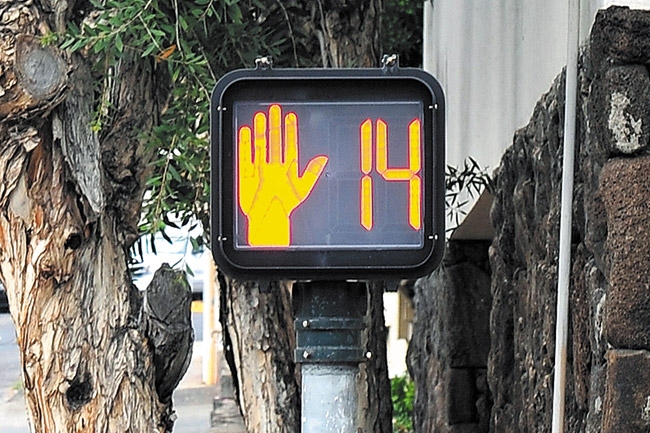Countdown To A Pedestrian Ticket
Pop quiz: You want to cross the street, and see this signal. Do you:
A) Enter the crosswalk and take your time getting to the other side, even if the countdown hits zero while you’re still crossing.
B) Stand at the curb, and wait for the next “pedestrian walk” signal.
C) Enter the crosswalk but walk really fast so that you get to the other side within 14 seconds.
D) Call out to your friend behind you to hurry up, and sprint across together before the light changes.
Correct answer: B
If you got that wrong, you’re not the only one. In a poll I conducted in the MidWeek office last week, 14 people said they would cross the street. Only three knew to wait at the curb for the next light or risk a citation. That’s right, you can get a ticket with a fine of $130 for entering a crosswalk once the signal starts counting down, even if you think you can make it across in the amount of time shown.
“It’s pretty clear what (the law) says: no pedestrian shall start to cross the roadway, whether it’s flashing or a steady (Don’t Walk) signal,” explains HPD Maj. Kurt Kendro. “The idea is that countdown clock, everybody says, well, I can still enter because that gives me enough time to cross the street, but the reality is that countdown signal is for the people who are already in the crosswalk to safely proceed across the roadway. It’s not for pedestrians to enter into the crosswalk.”
To be honest, I didn’t realize this rule until just a few months ago when I heard about people getting ticketed for it, including my aunty in her 70s. Now as I drive around, I can’t help but notice countless people dashing into crosswalks while the pedestrian signal is counting down, especially when I’m trying to make a turn but can’t because there are pedestrians in the roadway from when the light turns green to the second the upraised orange palm or “Don’t Walk” signal appears.
Each August, the state Department of Transportation’s Walk Wise Hawaii pedestrian safety program teams up with private and public partners, including HPD, to promote and educate pedestrian safety.
In August, there were 2,376 pedestrian offenses cited by HPD.
“Generally, jaywalking is probably the No. 1 offense,” notes Kendro. “Disregarding pedestrian walk signals is probably a close second. Normally, officers can and do give out these citations, but that may not always be their primary responsibility for that day.”
In their work of promoting safe walking habits, Walk Wise Hawaii teaches people to look left, look right and look left again, and to maintain eye contact with the driver of the vehicle that is stopped, as well as drivers in the other vehicles on the roadway.
And while the law prohibits drivers from holding a mobile electronic device, there currently is no law for pedestrians using smart-phones, MP3 players or even laptops while crossing the street.
“People are quick to blame the vehicle for hitting the pedestrian, but pedestrians have responsibilities as well,” says Kendro. “It’s one of those things that goes back to what your mother told you when you were a young kid crossing the street. Look both ways, pay attention and cross when it’s safe.
“Pedestrians have a false sense of security even if there’s a crosswalk and if they’ve made eye contact. You can be 100 percent right, but if that 4,000-pound car coming down the street at 25 miles per hour hits a pedestrian, it’s going to cause serious bodily injury or death. We have such mixed-used roadways, so pedestrians have to walk defensively and drivers have to anticipate the movements of pedestrians.”
So far this year, there have been 51 traffic fatalities on Oahu. Seventeen of those were pedestrians, 17 were in automobiles and 17 were on motorcycles/mopeds.
As for the rules of the roadway for drivers when a pedestrian is in a crosswalk, Kendro says, “If the pedestrian is on your half of the roadway, then you must stop for the pedestrian in the crosswalk until they leave your half of the roadway.”
These days, everyone seems to be in a rush, myself included. Between school, work, children’s activities, appointments and errands, we’re all driving or walking around from one place to another.
“Time is a commodity, we have to walk fast to get to where we need to, we got to drive to get to where we need to, but you’re talking about people’s lives,” says Kendro. “Drivers need to be patient and drive with aloha, and pedestrians wave a thank you to the driver.”
yting@midweek.com






